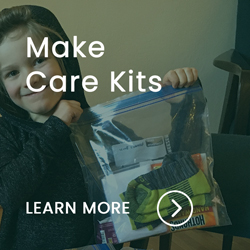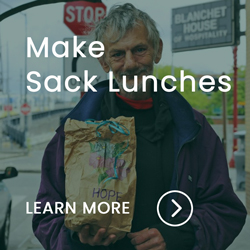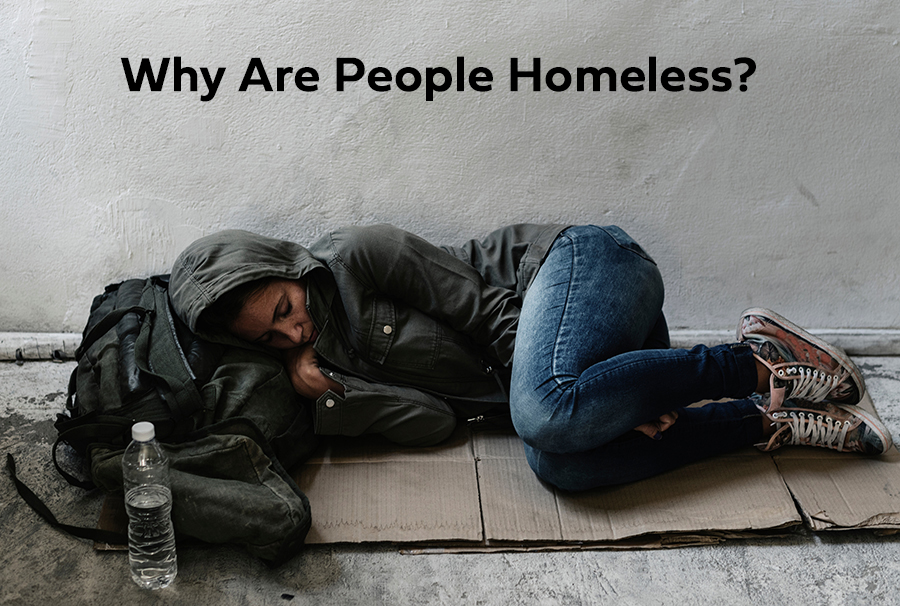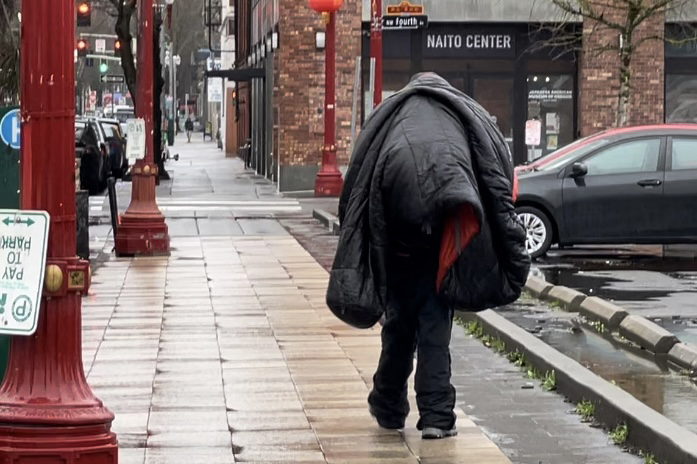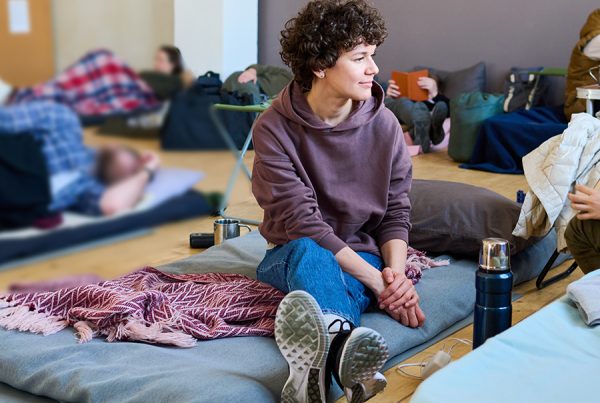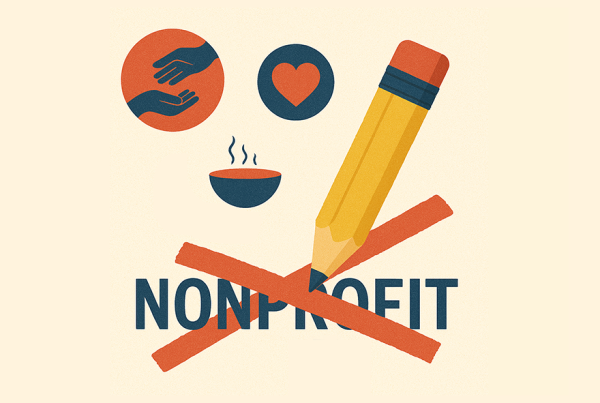One of the most common questions our staff is asked is: Why are people homeless? Closely followed by: How do we end homelessness? These are complex questions without tidy answers. We recognize that most people who ask are coming from a place of compassion and genuinely want to understand. If you’ve never experienced housing insecurity or struggled to meet your basic needs, it can be hard to imagine how someone ends up living on the street.
At Blanchet House, we talk with people every day who are doing their best to survive under incredibly difficult and inhumane circumstances. Most of them have experienced significant trauma, mental or physical health crises, or systems that failed them long before they walked through our doors. On top of that, people experiencing homelessness are often dehumanized, judged by their appearance, lack of access to hygiene, and the conditions they’re forced to live in.
Here’s the answer to Why are people homeless? Homelessness isn’t usually caused by one thing; it’s the result of a cascade of unfortunate events explained below. The more we understand that, the more compassion we can offer—and the more effectively we can work together toward real solutions to end homelessness.
Common Reasons People Become Homeless
These are the most common reasons people share with us, supported by national reporting and research, and what we witness daily in our community.
1. Lack of Affordable Housing
Finding and keeping an affordable place to live has become increasingly difficult in Portland and across the country. For people with low or fixed incomes, even a small studio apartment can be out of reach, with the average rent around $1,444 a month. At Blanchet House, we talk with many people who are employed but still can’t afford rent.
Why are there so few affordable places to live? In Oregon, OPB reports that the following factors contribute to inefficient housing stock:
- Years of Underbuilding. Oregon needs to build about 29,500 more homes each year to keep pace with growth.
- Population Growth. Oregon’s population grew by nearly 11% between 2010 and 2020, netting Oregon an extra seat in Congress.
- Demographic Change. More people are living alone or with a partner.
- Short-term Rentals or Vacation Homes. Second homes and short-term rentals take away from permanent housing stock.
There can also be significant barriers to securing affordable housing, such as good credit, rental history requirements, and the need for a security deposit plus first month’s rent. Location matters too, especially if you don’t have access to a car or reliable public transportation.
2. Mental Health Challenges
The impact of mental health challenges in our community is difficult to fully measure, in part because it relies on individuals self-identifying their struggles. What we do know is that mental illness doesn’t discriminate. Many of the houseless people we serve live with conditions like bipolar disorder, post-traumatic stress disorder (PTSD), brain injury, severe anxiety, major depressive disorder, or schizophrenia, without the ability to consistently access care. When mental health challenges go untreated, just getting through the day can be overwhelming, making it nearly impossible to maintain a job or stable housing.
According to the Substance Abuse and Mental Health Services Administration, 1 in 5 people experiencing homelessness in the U.S. is living with a serious mental health condition. And once you become homeless, it becomes even harder to access care and housing. Without a phone, ID, necessary paperwork, or contact with loved ones, it’s easy to become lost to the streets and estranged from the systems needed to serve you.
3. Substance Use and Addiction
Addiction should be viewed as an illness, not a moral failing. Addiction can contribute to a person’s homelessness by leading to job loss, strained family and friend relationships, and eviction. However, some individuals begin using substances only after becoming homeless, as a way to cope with the stress and trauma.
About 38% of people experiencing homelessness self-identify as having an alcohol use disorder, and 26% report other substance use issues, according to the National Coalition for the Homeless. Recovery from addiction requires quick and easy access to treatment, counseling, and stable housing, resources that are often out of reach. However, there is a severe lack of detox programs, treatment facilities, and transitional housing for people ready to recover. Evidence shows that first having a safe place to live, also known as the Housing First Model, can improve the chances of successful recovery.
As overdose and homelessness rates rise, we need integrated solutions that treat both issues together.
4. Poverty and Job Loss
Many people in our community live paycheck to paycheck. A single financial emergency, like a rent increase, car repair, illness, or job loss, can push someone or a family into homelessness. A 2023 report from the Federal Reserve found that nearly 40% of U.S. adults couldn’t cover a $400 emergency expense with cash or savings. At Blanchet House, we regularly meet people dining in our free café who need a little help during lean times, who were recently laid off, or who can’t afford rising rent despite working full-time.
In Portland, OR, the minimum wage is $15.95 per hour. This equates to approximately $2,552 per month for a full-time worker. The average rent for a studio apartment is around $1,444 per month, leaving limited funds for essential needs like food, transportation, and healthcare.
Consider the average monthly costs for these necessities in 2025:
-
$92 – TriMet bus pass
-
$150–$200 – Utilities (electricity, heating, cooling, water, garbage)
-
$60–$100 – Internet
-
$40–$60 – Phone
-
$500–$1,000 – Health insurance
-
$400 – Food
The total estimated monthly costs (excluding rent) range from $1,242 to $1,852. When you add the average rent of $1,444, the full monthly cost of living reaches approximately $2,686 to $3,296. In other words, a full-time minimum wage earner in Portland would spend more than they earn each month. This is what we mean when we say many people are just one unexpected expense away from losing their housing.
It’s also important to recognize intergenerational poverty. Childhood poverty can hinder economic mobility in adulthood, creating a cycle of disadvantage that persists across generations. Where children grow up is strongly correlated with whether they experience poverty later in life due to access to resources like good schools.
5. Systemic Inequities and Racism
A person’s homelessness is not just about individual circumstances, it’s also about systems. Racism—both historic and ongoing—plays a major role in who becomes homeless and who has access to housing, employment, healthcare, and opportunity.
In Multnomah County, Black residents make up just 2.5% of the general population but account for 6% of people experiencing homelessness, according to the 2023 Point-in-Time Count of Homelessness. This disproportionate impact is not a coincidence. It reflects generations of policies and practices that have excluded people of color from stable housing and economic security. For generations, a white supremacist system denied home loans to Black families and other communities of color, locking them out of homeownership, the primary way American families build generational wealth.
6. Family Conflict and Domestic Violence
Many of the women and youth we serve became homeless after fleeing abusive homes. Without financial resources or a safe place to go, they often turn to shelters or the streets for survival. Domestic violence is the leading cause of homelessness for women, with approximately 63% of homeless women reporting experiences of domestic violence in adulthood, according to the National Network to End Domestic Violence.
This reality is especially stark for LGBTQ+ youth, who often face family rejection. In 2022, The Trevor Project reported that 28% of LGBTQ youth had experienced homelessness or housing instability at some point in their lives.
7. Criminal Record
A report by the Prison Policy Initiative finds that formerly incarcerated people are nearly 10 times more likely to be homeless than the general public. Incarceration can lead to the immediate loss of both housing and employment, leaving individuals without a place to live or a means of support upon release. People with criminal records often face discrimination when applying for housing and jobs. This makes it even more difficult to find stability and rebuild their lives.
A nonviolent felony, such as property damage, theft, or possession of controlled substances, can remain on a person’s record permanently unless it is expunged. Even if the offense occurred more than a decade ago, it can still prevent someone from securing housing due to fear and discrimination.
Why Understanding Homelessness Matters
When you ask Why Are People Homeless, know that there’s rarely a single reason why someone becomes homeless. But instead it is often the result of overlapping challenges. Homelessness isn’t a reflection of personal failure but of systems that have failed to provide support when it was needed most.
At Blanchet House, we see the humanity in everyone. Each person we serve deserves compassion, not judgment. Ending homelessness starts with empathy. Then continues through action by advocating for housing, supporting recovery, and building communities where everyone has the chance to thrive.
If you still have questions about homelessness after reading this, please email us at info@blanchethouse.org.
–Written by Julie Showers






